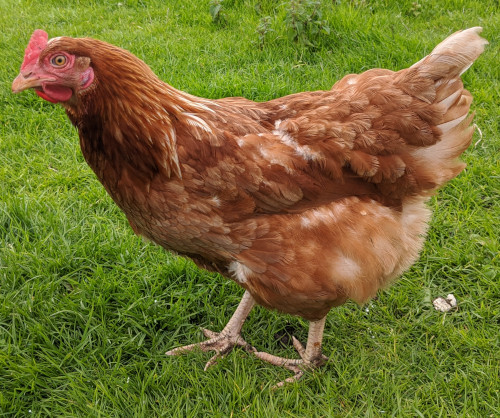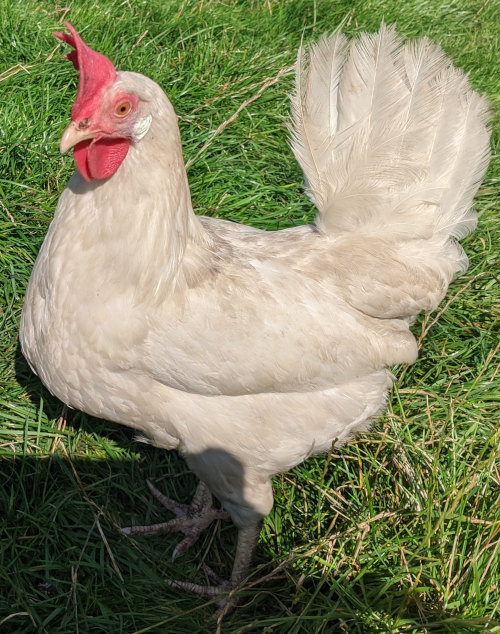Laying hens and their care.

A few laying hens can provide ample eggs for the average family, plenty for breakfast, baking and even the occasional quiche.
Table of Contents
- What is a laying hen?
- Types of laying hens:
- What do laying hens need?
- What is the average lifespan of a laying hen?
- Where to get laying hens and how much to pay for them:
- When should I buy a laying hen?
- How long should you keep laying hens?
- Laying hens and the law:
- What to do with old laying hens?
- Can you eat a laying hen?
Even if your family doesn’t eat many eggs each week currently, you may find that that changes when you are raising laying hens and have a fresh, steady egg supply from your own little flock.
What is a laying hen?
Laying hen is the collective term for fully grown female chickens kept for the purpose of laying eggs. Laying hens can be hybrids, bantams or heritage chickens as long as they are at least 1 year old.
Below: This is the standard red laying hen, responsible for around 70% of the worlds eggs.

When you first transition the hens to their new home, they may stop laying for a few days or even longer. It might be best to buy pullets that have not yet started laying in order to minimise interruptions in their laying cycle.
Types of laying hens:
While all hens lay eggs, there are several top egg-producing chicken breeds to consider when purchasing your laying hens.
Other than sex linked hybrids, there is no particular breed that makes the best egg laying chickens for beginners, but some may be more appealing to you based on colouring, egg colour, size and other aspects.
Types of laying hens:
- Hybrid hens are modern sex linked and highly productive chickens.
- Heritage hens are traditional birds with a history and pedigree.
- Bantams and smaller versions of large fowl.
- True bantams are very small and kept more for ornamental reasons.
When choosing breeds of egg laying chickens, don’t be afraid to pick a variety that you like based on its looks.
Below: Choosing your laying hens because you like the look of them is a perfectly valid reason.

In the end, the chickens you choose are often a matter of preference in addition to practical concerns such as laying statistics.
What do laying hens need?
After acquiring or raising your laying hens, ensure that they have clean, cosy laying boxes in which to nest. Bedding or straw should be put into the boxes and changed when overly soiled.
Laying hens need:
- A warm, dry and draught free coop,
- Fresh clean water,
- Nutritious food,
- Perches and roosts,
- Nesting boxes,
- A dust bath,
- An area to scratch in.
- Enough space.
When a hen lays her first egg she might not even realise what’s happening and lay it as she walks along. After a few times, she catches on and will begin to lay in a more regular fashion.
Below: Some of my flock of laying hens free ranging in the fields.
You can encourage her by putting a false egg in her nesting area. She will think it must be a safe place to lay an egg, and soon your laying hens will be trained to deposit their eggs in the same spot.
Some renegade hens like to lay outside the nesting boxes or away from prying eyes.
Collect new eggs daily to prevent loss due to cracking or even eating by over zealous or curious chickens.
Raising laying hens is a fun adventure, and it can be quite satisfying and profitable too.
What is the average lifespan of a laying hen?
The average lifespan of a laying hen is five to six years. Heritage laying hens live longer than hybrid hens but lay roughly the same number of eggs over the course of their lifetime.
Below: A white leghorn laying hen.

Actual lifespan does depend on the breed to some extent but also the living conditions and local predators.
Where to get laying hens and how much to pay for them:
You can buy laying hen from pullet rearing farms, private breeders and livestock auctions. Facebook groups is a good place to start, especially if you want heritage or rare breed laying hens.
The cost of young laying hens will be $10 to $15 (£7.50 to £11) each for hybrids and $30 to $50 (£22 to £40) for heritage breed laying hens. Bulk discounts are sometimes available.
I once paid £260 ( nearly $400) for a trio of young birds but they had an excellent pedigree.
Cost is depending on your location and the availability of stock.
It is often difficult to find laying hens for sale simply because once people put the effort into raising chicks they are loath to part with their best laying hens.
If you don’t want to raise chicks, or want eggs more quickly than the months it takes chicks to mature, it’s best to buy pullets, which are young hens, less than a year old, within a few weeks of laying or have just begun laying.
You may find older hens for sale, but they likely won’t lay well and may be best for the stew pot.
See “how can you tell if a hen is old” to learn more.
When should I buy a laying hen?
The best time to invest in laying hens is early spring as they will start laying eggs much sooner than hens bough at any other time of the year.
If you buy laying hens in the fall you could end up waiting months for eggs.
How long should you keep laying hens?
Commercially hens are kept for between 72 and 80 weeks. After this the eggs quality begins to deteriorate and they become known as spent hens.
For the backyard keeper laying hens are often kept until the end of their natural lives.
I keep all my hens to the end of their lives as I mostly have the more valuable heritage and rare breeds.
Laying hens and the law:
In most parts of the world the keeping of poultry is governed by certain laws, both nationally and locally.
Here in the UK and the EU chickens must have:
- At least 750 cm² of cage area per hen,
- One nest for every 7 hens,
- Adequate perches,
- A litter area to allow scratching and pecking,
- Unrestricted access to fresh food and clean water,
- 45 cm of headroom,
In addition keepers must see that their hens are given the five freedoms and allowed to express their natural behaviours.
What to do with old laying hens?
I like to keep my old hens about. One of my elderly Barnevelder hens would adopt any chicks you gave her regardless of the time of year, she was a permanent broody.
Old hens can be used to teach the younger ones the ways of the coop as sometimes shed reared laying hens struggle to perch naturally.
Can you eat a laying hen?
This was how things worked in the good old days, when you didn't have enough eggs, you ate the hens and got some new ones.
You can eat laying hens. Bear in mind you will be eating the source of your eggs and old hens will be as tough as boot leather.
From a purely financial point of view, the profitability of chickens decreases after three years of age
